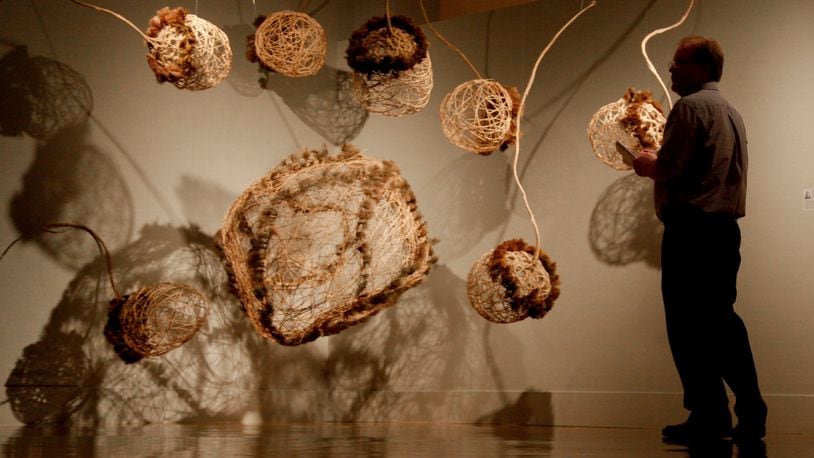Some of the artists represented in the collection as well as a delegation of Chinese businessmen and business women were in town Thursday to meet with the museum staff and view the show.
With the help of a translator, artist Lin Lecheng said he was honored to have his work shown at a museum with such rich history and such a fine collection.
“Fabulous!” he responded, when asked his reaction to the way in which his art was displayed.
In addition to Morrisette, credit goes to DAI exhibition designer Martin Pleiss and museum technician Erich Reith, who’ve selected dramatic hues and lighting for each gallery to enhance each piece of art.
Morrisette says this particular exhibit is “extraordinarily accessible” to everyone.
“People don’t need to know anything about China or anything about contemporary art to enjoy it,” she says. “ They just need to leave themselves open to the experience.”
The 48 artists represented have competed for the honor of being part of China’s International Fiber Art Biennales during the past five years and represent three generations of Chinese artists.
The official title is “Changing Landscapes: Contemporary Chinese Fiber Art” but don’t come expecting to see traditional scenes of China or traditional tapestry. This is China in a metaphorical sense — as filtered through the feelings and experiences of each artist. You’ll see everything from three-dimensional hanging sculptures to bold orange-and-gold chairs fashioned of metal, wool and plastic.
One room is devoted to a striking boat-like creation that’s also reminiscent of a crescent moon. To a stainless steel base, artist Zhao Dandan has added wispy strands of fishing wire to fashion a piece that evokes a dream-like effect. In “The Colorful Poem of the Blind,” artist Wang Lin places sequined braille patterns over vivid quilted cotton.
“I created this piece to pay tribute to the indomitable spirit of the blind,” she writes. “Although they have lost their sight, their inner worlds are blazing with color.”
Subject matter ranges from nostalgic childhood memories of flowering fields to the challenging issues facing modern China such as pollution and housing.
In the final gallery is Maya Lin’s compelling installation “Flow.” It consists of thousands of 2x4’s cut and arranged to suggest hills or waves.
Lin is best known for the Vietnam Veterans Memorial in Washington; her design was selected from among 1,420 submissions when she was a 21-year-old senior at Yale University. She’s since completed a number of public monuments, earthworks and installations.
Morrisette says it’s the concept of landscape that connects the two exhibits.
“Much of Lin’s work has to do with an approach to landscape,” she explains. “Her work defies categorization and moves between boundaries.”
The crates that contained the Lin exhibit also are on display and fun to see. A locally-made film features the five-day installation process in time-lapse photography. Visitors also are invited to share their ideas about landscape.
The fiber show comes to Dayton from the San Jose Museum of Quilts and Textiles in California, where Deborah Corsini served as exhibition co-curator. Joining her was Li Dang Qi, dean of the Academy of Arts & Design at Tsinghua University in China.
Corsini, who has worked as a weaver, teacher and textile designer herself, is in town for the opening and will speak at 2 p.m. today. She says fiber not only offers endless possibilities for artists but speaks to people because it is so much a part of our everyday lives. “It’s cloth that we live in and are surrounded by,” she observes.
“I love the history and what contemporary artists are doing with it,” Corsini adds. “They are using ancient techniques to create powerful work, and this exhibit really gives audiences a unique opportunity to see what’s going on in the world of contemporary fiber in other countries.”
Although it is definitely influenced by the themes and forms of historic Chinese art — hanging scrolls, cranes, shadow puppets, seals — Corsini says the art on display is “pushing into the future.”
“Some of the pieces are really colorful, very dramatic, very beautiful, and there’s a lot of abstraction, a lot of nature-inspired work,” Corsini says. Many of the pieces incorporate unusual materials — metal, wood, plastics, organic pieces such as branches. Techniques used include tapestry and pile weaving, embroidery, printing, dyeing.
